HMG7130 - Case Study: Malnutrition in Children in Ethiopia
VerifiedAdded on 2023/03/20
|14
|4262
|97
Case Study
AI Summary
This case study examines the critical health issue of malnutrition among children in Ethiopia, highlighting the prevalence of undernutrition, stunting, and wasting. It delves into the immediate and underlying causes of malnutrition, including poor diets, diseases, inadequate care, and socio-economic factors. The study explores the dire consequences of malnutrition, such as increased mortality risk, lowered productivity, poor school performance, poverty perpetuation, and intergenerational cycles. It analyzes the National Nutrition Program (NNP I, 2008-2015), evaluating its strategies for addressing malnutrition through nutrition-specific and sensitive interventions. The case study also critiques the program's effectiveness, discusses the government's efforts, and offers evidence-based interventions to overcome barriers and achieve malnutrition mitigation goals. The analysis underscores the need for comprehensive strategies to improve the health and well-being of Ethiopian children.

MALNUTRITION IN CHILDREN IN ETHIOPIA
Name of the student:
Name of the university:
Author note:
Name of the student:
Name of the university:
Author note:
Paraphrase This Document
Need a fresh take? Get an instant paraphrase of this document with our AI Paraphraser
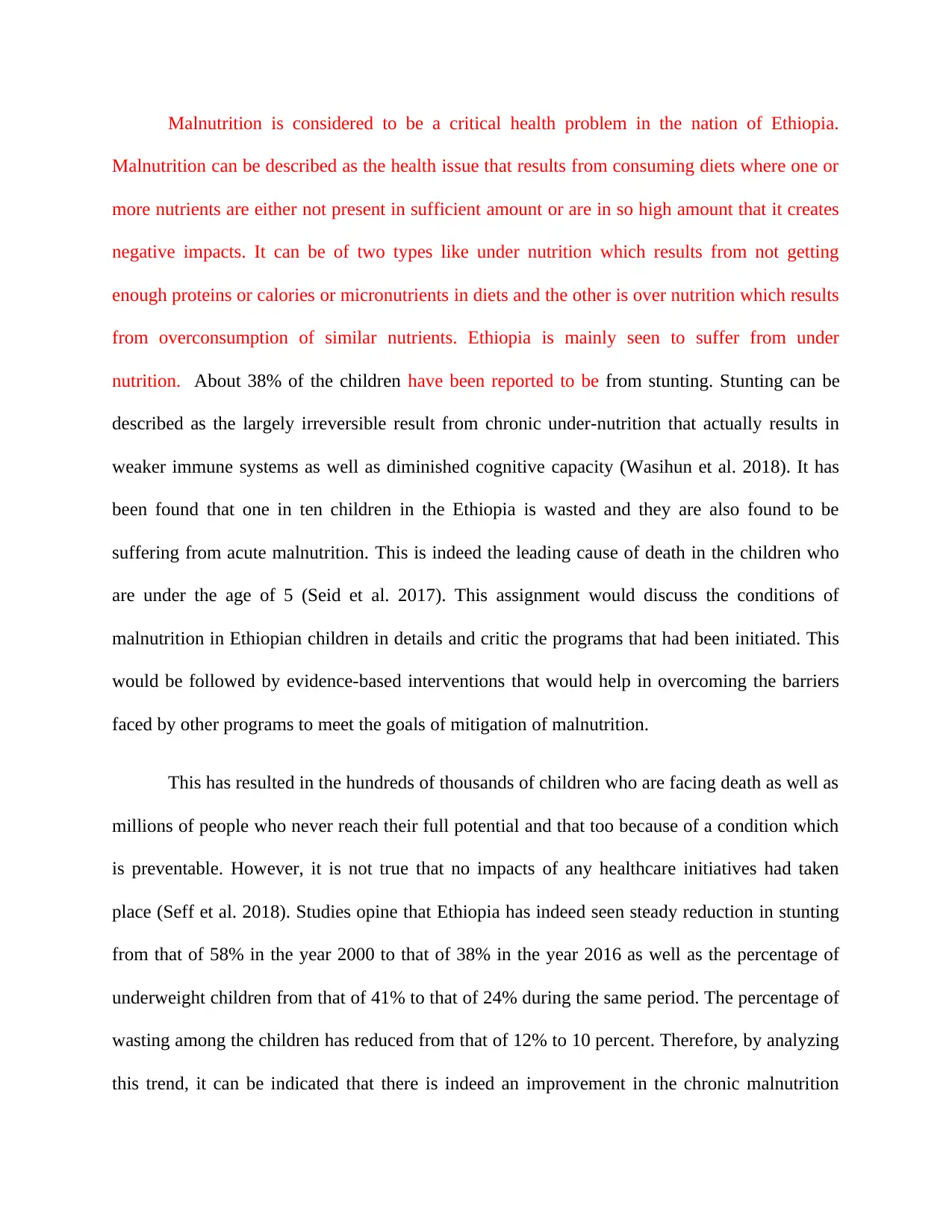
Malnutrition is considered to be a critical health problem in the nation of Ethiopia.
Malnutrition can be described as the health issue that results from consuming diets where one or
more nutrients are either not present in sufficient amount or are in so high amount that it creates
negative impacts. It can be of two types like under nutrition which results from not getting
enough proteins or calories or micronutrients in diets and the other is over nutrition which results
from overconsumption of similar nutrients. Ethiopia is mainly seen to suffer from under
nutrition. About 38% of the children have been reported to be from stunting. Stunting can be
described as the largely irreversible result from chronic under-nutrition that actually results in
weaker immune systems as well as diminished cognitive capacity (Wasihun et al. 2018). It has
been found that one in ten children in the Ethiopia is wasted and they are also found to be
suffering from acute malnutrition. This is indeed the leading cause of death in the children who
are under the age of 5 (Seid et al. 2017). This assignment would discuss the conditions of
malnutrition in Ethiopian children in details and critic the programs that had been initiated. This
would be followed by evidence-based interventions that would help in overcoming the barriers
faced by other programs to meet the goals of mitigation of malnutrition.
This has resulted in the hundreds of thousands of children who are facing death as well as
millions of people who never reach their full potential and that too because of a condition which
is preventable. However, it is not true that no impacts of any healthcare initiatives had taken
place (Seff et al. 2018). Studies opine that Ethiopia has indeed seen steady reduction in stunting
from that of 58% in the year 2000 to that of 38% in the year 2016 as well as the percentage of
underweight children from that of 41% to that of 24% during the same period. The percentage of
wasting among the children has reduced from that of 12% to 10 percent. Therefore, by analyzing
this trend, it can be indicated that there is indeed an improvement in the chronic malnutrition
Malnutrition can be described as the health issue that results from consuming diets where one or
more nutrients are either not present in sufficient amount or are in so high amount that it creates
negative impacts. It can be of two types like under nutrition which results from not getting
enough proteins or calories or micronutrients in diets and the other is over nutrition which results
from overconsumption of similar nutrients. Ethiopia is mainly seen to suffer from under
nutrition. About 38% of the children have been reported to be from stunting. Stunting can be
described as the largely irreversible result from chronic under-nutrition that actually results in
weaker immune systems as well as diminished cognitive capacity (Wasihun et al. 2018). It has
been found that one in ten children in the Ethiopia is wasted and they are also found to be
suffering from acute malnutrition. This is indeed the leading cause of death in the children who
are under the age of 5 (Seid et al. 2017). This assignment would discuss the conditions of
malnutrition in Ethiopian children in details and critic the programs that had been initiated. This
would be followed by evidence-based interventions that would help in overcoming the barriers
faced by other programs to meet the goals of mitigation of malnutrition.
This has resulted in the hundreds of thousands of children who are facing death as well as
millions of people who never reach their full potential and that too because of a condition which
is preventable. However, it is not true that no impacts of any healthcare initiatives had taken
place (Seff et al. 2018). Studies opine that Ethiopia has indeed seen steady reduction in stunting
from that of 58% in the year 2000 to that of 38% in the year 2016 as well as the percentage of
underweight children from that of 41% to that of 24% during the same period. The percentage of
wasting among the children has reduced from that of 12% to 10 percent. Therefore, by analyzing
this trend, it can be indicated that there is indeed an improvement in the chronic malnutrition
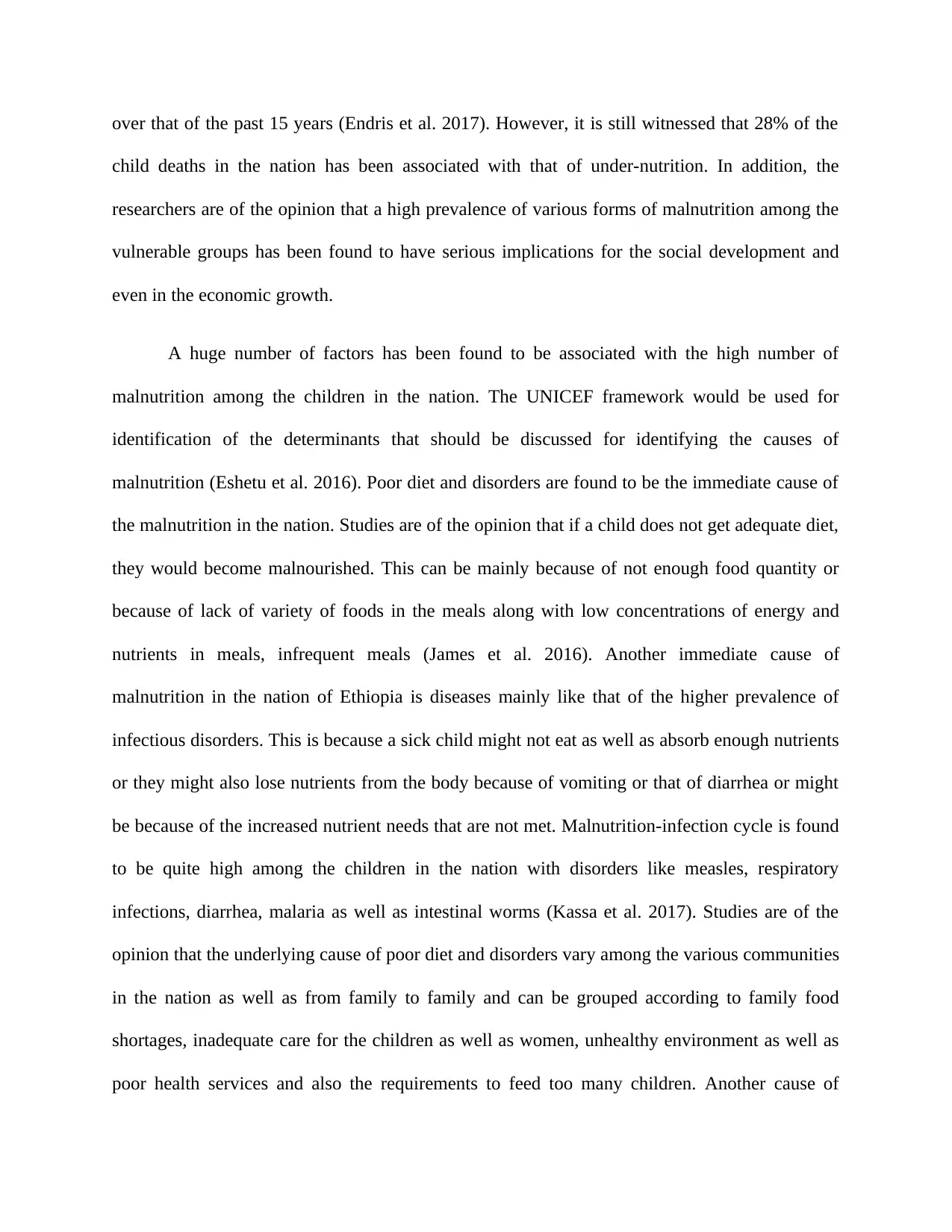
over that of the past 15 years (Endris et al. 2017). However, it is still witnessed that 28% of the
child deaths in the nation has been associated with that of under-nutrition. In addition, the
researchers are of the opinion that a high prevalence of various forms of malnutrition among the
vulnerable groups has been found to have serious implications for the social development and
even in the economic growth.
A huge number of factors has been found to be associated with the high number of
malnutrition among the children in the nation. The UNICEF framework would be used for
identification of the determinants that should be discussed for identifying the causes of
malnutrition (Eshetu et al. 2016). Poor diet and disorders are found to be the immediate cause of
the malnutrition in the nation. Studies are of the opinion that if a child does not get adequate diet,
they would become malnourished. This can be mainly because of not enough food quantity or
because of lack of variety of foods in the meals along with low concentrations of energy and
nutrients in meals, infrequent meals (James et al. 2016). Another immediate cause of
malnutrition in the nation of Ethiopia is diseases mainly like that of the higher prevalence of
infectious disorders. This is because a sick child might not eat as well as absorb enough nutrients
or they might also lose nutrients from the body because of vomiting or that of diarrhea or might
be because of the increased nutrient needs that are not met. Malnutrition-infection cycle is found
to be quite high among the children in the nation with disorders like measles, respiratory
infections, diarrhea, malaria as well as intestinal worms (Kassa et al. 2017). Studies are of the
opinion that the underlying cause of poor diet and disorders vary among the various communities
in the nation as well as from family to family and can be grouped according to family food
shortages, inadequate care for the children as well as women, unhealthy environment as well as
poor health services and also the requirements to feed too many children. Another cause of
child deaths in the nation has been associated with that of under-nutrition. In addition, the
researchers are of the opinion that a high prevalence of various forms of malnutrition among the
vulnerable groups has been found to have serious implications for the social development and
even in the economic growth.
A huge number of factors has been found to be associated with the high number of
malnutrition among the children in the nation. The UNICEF framework would be used for
identification of the determinants that should be discussed for identifying the causes of
malnutrition (Eshetu et al. 2016). Poor diet and disorders are found to be the immediate cause of
the malnutrition in the nation. Studies are of the opinion that if a child does not get adequate diet,
they would become malnourished. This can be mainly because of not enough food quantity or
because of lack of variety of foods in the meals along with low concentrations of energy and
nutrients in meals, infrequent meals (James et al. 2016). Another immediate cause of
malnutrition in the nation of Ethiopia is diseases mainly like that of the higher prevalence of
infectious disorders. This is because a sick child might not eat as well as absorb enough nutrients
or they might also lose nutrients from the body because of vomiting or that of diarrhea or might
be because of the increased nutrient needs that are not met. Malnutrition-infection cycle is found
to be quite high among the children in the nation with disorders like measles, respiratory
infections, diarrhea, malaria as well as intestinal worms (Kassa et al. 2017). Studies are of the
opinion that the underlying cause of poor diet and disorders vary among the various communities
in the nation as well as from family to family and can be grouped according to family food
shortages, inadequate care for the children as well as women, unhealthy environment as well as
poor health services and also the requirements to feed too many children. Another cause of
⊘ This is a preview!⊘
Do you want full access?
Subscribe today to unlock all pages.

Trusted by 1+ million students worldwide
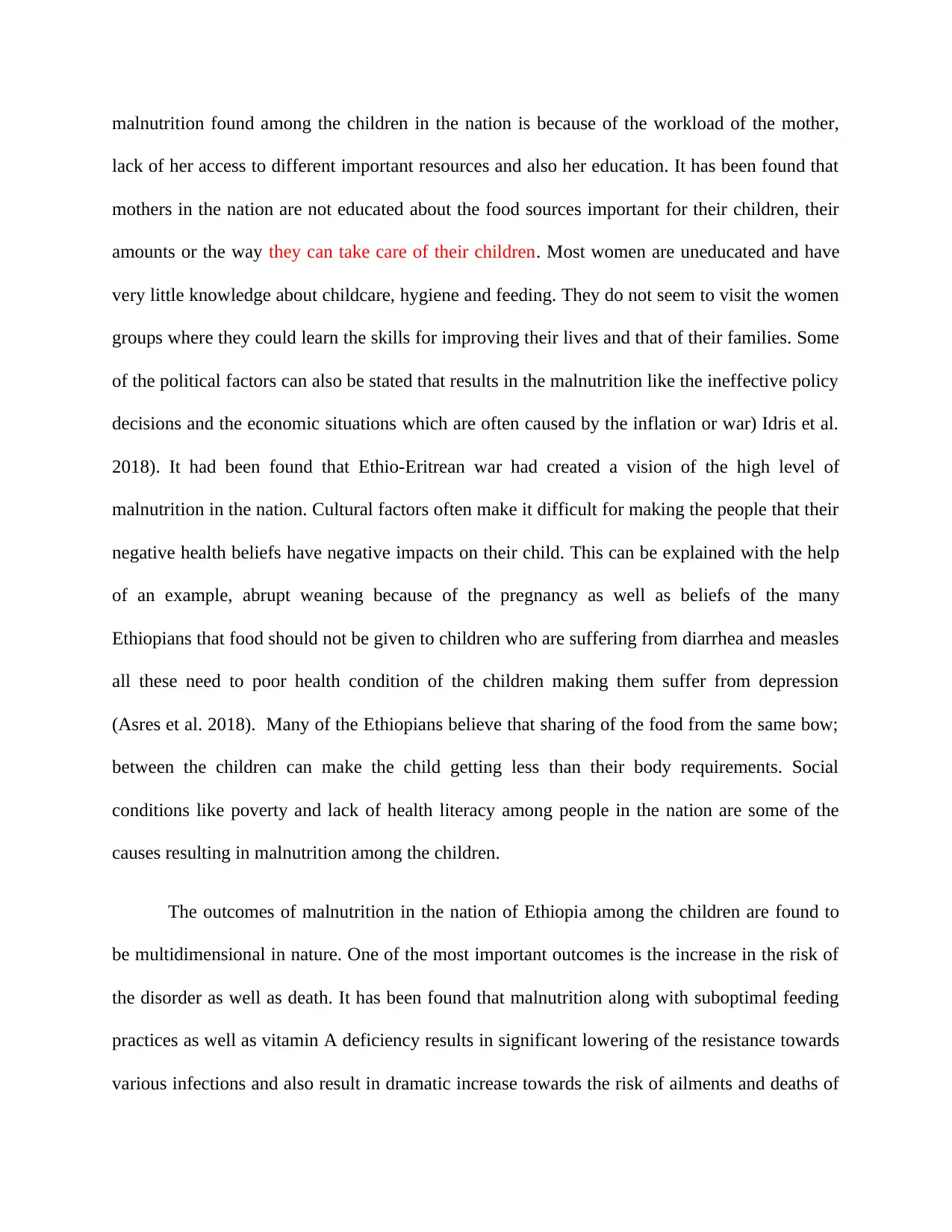
malnutrition found among the children in the nation is because of the workload of the mother,
lack of her access to different important resources and also her education. It has been found that
mothers in the nation are not educated about the food sources important for their children, their
amounts or the way they can take care of their children. Most women are uneducated and have
very little knowledge about childcare, hygiene and feeding. They do not seem to visit the women
groups where they could learn the skills for improving their lives and that of their families. Some
of the political factors can also be stated that results in the malnutrition like the ineffective policy
decisions and the economic situations which are often caused by the inflation or war) Idris et al.
2018). It had been found that Ethio-Eritrean war had created a vision of the high level of
malnutrition in the nation. Cultural factors often make it difficult for making the people that their
negative health beliefs have negative impacts on their child. This can be explained with the help
of an example, abrupt weaning because of the pregnancy as well as beliefs of the many
Ethiopians that food should not be given to children who are suffering from diarrhea and measles
all these need to poor health condition of the children making them suffer from depression
(Asres et al. 2018). Many of the Ethiopians believe that sharing of the food from the same bow;
between the children can make the child getting less than their body requirements. Social
conditions like poverty and lack of health literacy among people in the nation are some of the
causes resulting in malnutrition among the children.
The outcomes of malnutrition in the nation of Ethiopia among the children are found to
be multidimensional in nature. One of the most important outcomes is the increase in the risk of
the disorder as well as death. It has been found that malnutrition along with suboptimal feeding
practices as well as vitamin A deficiency results in significant lowering of the resistance towards
various infections and also result in dramatic increase towards the risk of ailments and deaths of
lack of her access to different important resources and also her education. It has been found that
mothers in the nation are not educated about the food sources important for their children, their
amounts or the way they can take care of their children. Most women are uneducated and have
very little knowledge about childcare, hygiene and feeding. They do not seem to visit the women
groups where they could learn the skills for improving their lives and that of their families. Some
of the political factors can also be stated that results in the malnutrition like the ineffective policy
decisions and the economic situations which are often caused by the inflation or war) Idris et al.
2018). It had been found that Ethio-Eritrean war had created a vision of the high level of
malnutrition in the nation. Cultural factors often make it difficult for making the people that their
negative health beliefs have negative impacts on their child. This can be explained with the help
of an example, abrupt weaning because of the pregnancy as well as beliefs of the many
Ethiopians that food should not be given to children who are suffering from diarrhea and measles
all these need to poor health condition of the children making them suffer from depression
(Asres et al. 2018). Many of the Ethiopians believe that sharing of the food from the same bow;
between the children can make the child getting less than their body requirements. Social
conditions like poverty and lack of health literacy among people in the nation are some of the
causes resulting in malnutrition among the children.
The outcomes of malnutrition in the nation of Ethiopia among the children are found to
be multidimensional in nature. One of the most important outcomes is the increase in the risk of
the disorder as well as death. It has been found that malnutrition along with suboptimal feeding
practices as well as vitamin A deficiency results in significant lowering of the resistance towards
various infections and also result in dramatic increase towards the risk of ailments and deaths of
Paraphrase This Document
Need a fresh take? Get an instant paraphrase of this document with our AI Paraphraser
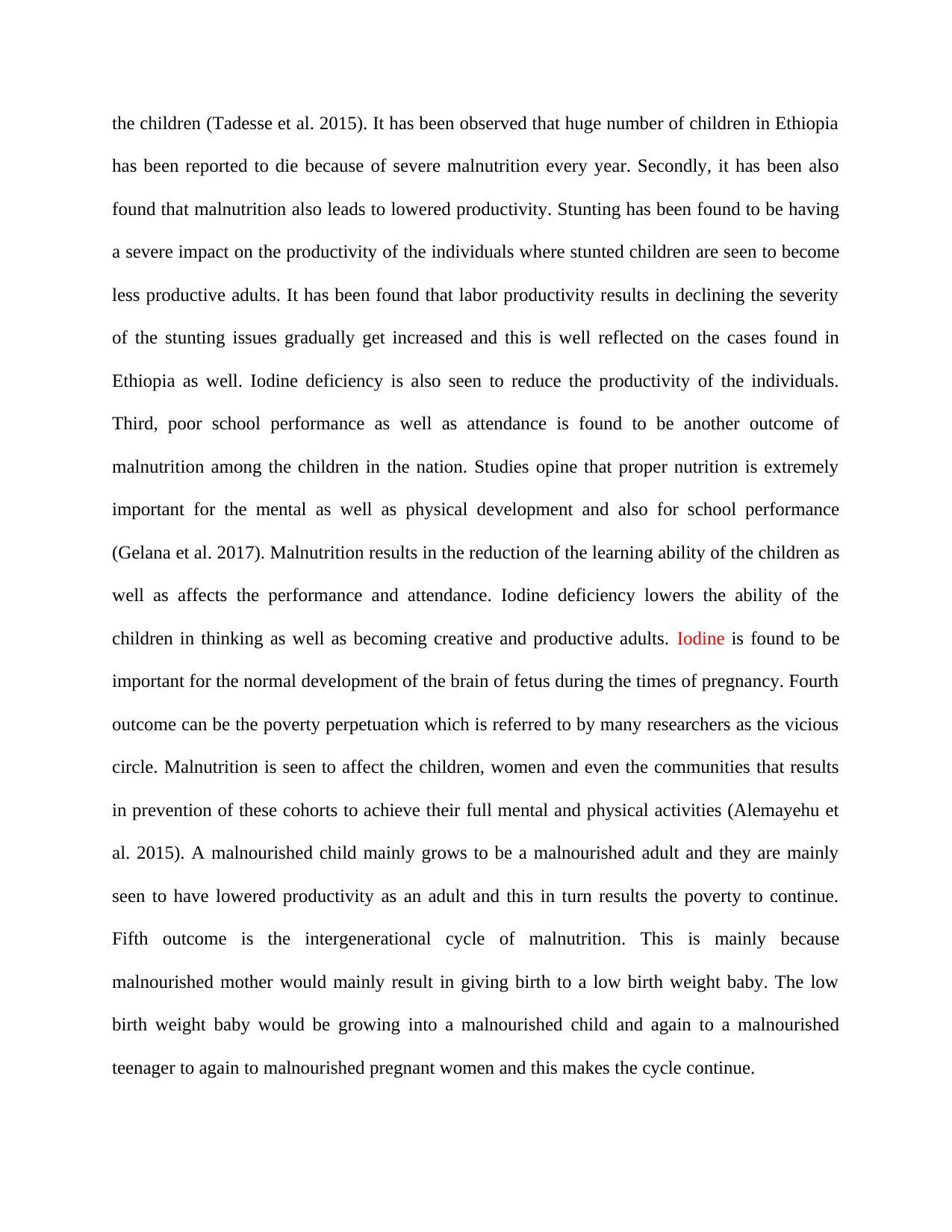
the children (Tadesse et al. 2015). It has been observed that huge number of children in Ethiopia
has been reported to die because of severe malnutrition every year. Secondly, it has been also
found that malnutrition also leads to lowered productivity. Stunting has been found to be having
a severe impact on the productivity of the individuals where stunted children are seen to become
less productive adults. It has been found that labor productivity results in declining the severity
of the stunting issues gradually get increased and this is well reflected on the cases found in
Ethiopia as well. Iodine deficiency is also seen to reduce the productivity of the individuals.
Third, poor school performance as well as attendance is found to be another outcome of
malnutrition among the children in the nation. Studies opine that proper nutrition is extremely
important for the mental as well as physical development and also for school performance
(Gelana et al. 2017). Malnutrition results in the reduction of the learning ability of the children as
well as affects the performance and attendance. Iodine deficiency lowers the ability of the
children in thinking as well as becoming creative and productive adults. Iodine is found to be
important for the normal development of the brain of fetus during the times of pregnancy. Fourth
outcome can be the poverty perpetuation which is referred to by many researchers as the vicious
circle. Malnutrition is seen to affect the children, women and even the communities that results
in prevention of these cohorts to achieve their full mental and physical activities (Alemayehu et
al. 2015). A malnourished child mainly grows to be a malnourished adult and they are mainly
seen to have lowered productivity as an adult and this in turn results the poverty to continue.
Fifth outcome is the intergenerational cycle of malnutrition. This is mainly because
malnourished mother would mainly result in giving birth to a low birth weight baby. The low
birth weight baby would be growing into a malnourished child and again to a malnourished
teenager to again to malnourished pregnant women and this makes the cycle continue.
has been reported to die because of severe malnutrition every year. Secondly, it has been also
found that malnutrition also leads to lowered productivity. Stunting has been found to be having
a severe impact on the productivity of the individuals where stunted children are seen to become
less productive adults. It has been found that labor productivity results in declining the severity
of the stunting issues gradually get increased and this is well reflected on the cases found in
Ethiopia as well. Iodine deficiency is also seen to reduce the productivity of the individuals.
Third, poor school performance as well as attendance is found to be another outcome of
malnutrition among the children in the nation. Studies opine that proper nutrition is extremely
important for the mental as well as physical development and also for school performance
(Gelana et al. 2017). Malnutrition results in the reduction of the learning ability of the children as
well as affects the performance and attendance. Iodine deficiency lowers the ability of the
children in thinking as well as becoming creative and productive adults. Iodine is found to be
important for the normal development of the brain of fetus during the times of pregnancy. Fourth
outcome can be the poverty perpetuation which is referred to by many researchers as the vicious
circle. Malnutrition is seen to affect the children, women and even the communities that results
in prevention of these cohorts to achieve their full mental and physical activities (Alemayehu et
al. 2015). A malnourished child mainly grows to be a malnourished adult and they are mainly
seen to have lowered productivity as an adult and this in turn results the poverty to continue.
Fifth outcome is the intergenerational cycle of malnutrition. This is mainly because
malnourished mother would mainly result in giving birth to a low birth weight baby. The low
birth weight baby would be growing into a malnourished child and again to a malnourished
teenager to again to malnourished pregnant women and this makes the cycle continue.
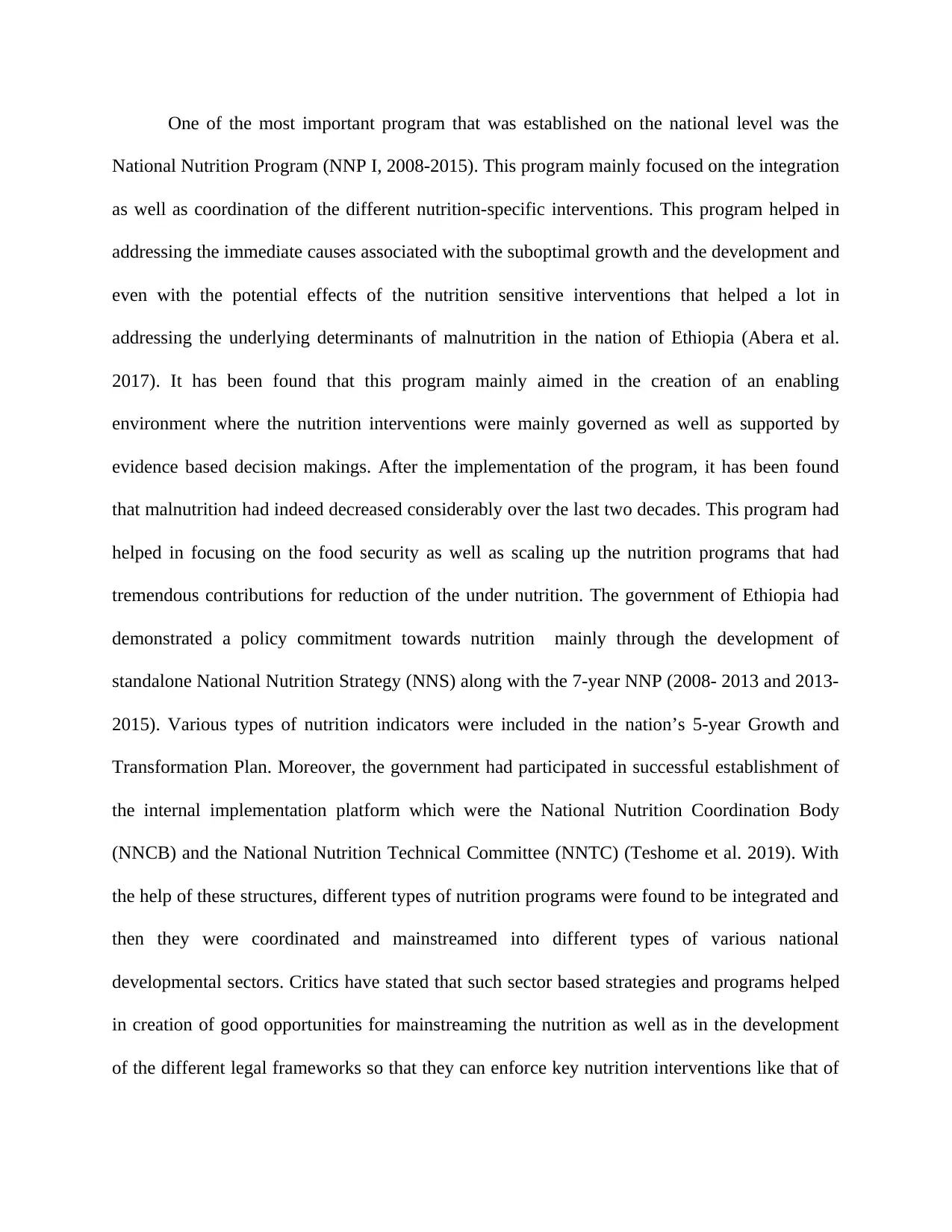
One of the most important program that was established on the national level was the
National Nutrition Program (NNP I, 2008-2015). This program mainly focused on the integration
as well as coordination of the different nutrition-specific interventions. This program helped in
addressing the immediate causes associated with the suboptimal growth and the development and
even with the potential effects of the nutrition sensitive interventions that helped a lot in
addressing the underlying determinants of malnutrition in the nation of Ethiopia (Abera et al.
2017). It has been found that this program mainly aimed in the creation of an enabling
environment where the nutrition interventions were mainly governed as well as supported by
evidence based decision makings. After the implementation of the program, it has been found
that malnutrition had indeed decreased considerably over the last two decades. This program had
helped in focusing on the food security as well as scaling up the nutrition programs that had
tremendous contributions for reduction of the under nutrition. The government of Ethiopia had
demonstrated a policy commitment towards nutrition mainly through the development of
standalone National Nutrition Strategy (NNS) along with the 7-year NNP (2008- 2013 and 2013-
2015). Various types of nutrition indicators were included in the nation’s 5-year Growth and
Transformation Plan. Moreover, the government had participated in successful establishment of
the internal implementation platform which were the National Nutrition Coordination Body
(NNCB) and the National Nutrition Technical Committee (NNTC) (Teshome et al. 2019). With
the help of these structures, different types of nutrition programs were found to be integrated and
then they were coordinated and mainstreamed into different types of various national
developmental sectors. Critics have stated that such sector based strategies and programs helped
in creation of good opportunities for mainstreaming the nutrition as well as in the development
of the different legal frameworks so that they can enforce key nutrition interventions like that of
National Nutrition Program (NNP I, 2008-2015). This program mainly focused on the integration
as well as coordination of the different nutrition-specific interventions. This program helped in
addressing the immediate causes associated with the suboptimal growth and the development and
even with the potential effects of the nutrition sensitive interventions that helped a lot in
addressing the underlying determinants of malnutrition in the nation of Ethiopia (Abera et al.
2017). It has been found that this program mainly aimed in the creation of an enabling
environment where the nutrition interventions were mainly governed as well as supported by
evidence based decision makings. After the implementation of the program, it has been found
that malnutrition had indeed decreased considerably over the last two decades. This program had
helped in focusing on the food security as well as scaling up the nutrition programs that had
tremendous contributions for reduction of the under nutrition. The government of Ethiopia had
demonstrated a policy commitment towards nutrition mainly through the development of
standalone National Nutrition Strategy (NNS) along with the 7-year NNP (2008- 2013 and 2013-
2015). Various types of nutrition indicators were included in the nation’s 5-year Growth and
Transformation Plan. Moreover, the government had participated in successful establishment of
the internal implementation platform which were the National Nutrition Coordination Body
(NNCB) and the National Nutrition Technical Committee (NNTC) (Teshome et al. 2019). With
the help of these structures, different types of nutrition programs were found to be integrated and
then they were coordinated and mainstreamed into different types of various national
developmental sectors. Critics have stated that such sector based strategies and programs helped
in creation of good opportunities for mainstreaming the nutrition as well as in the development
of the different legal frameworks so that they can enforce key nutrition interventions like that of
⊘ This is a preview!⊘
Do you want full access?
Subscribe today to unlock all pages.

Trusted by 1+ million students worldwide
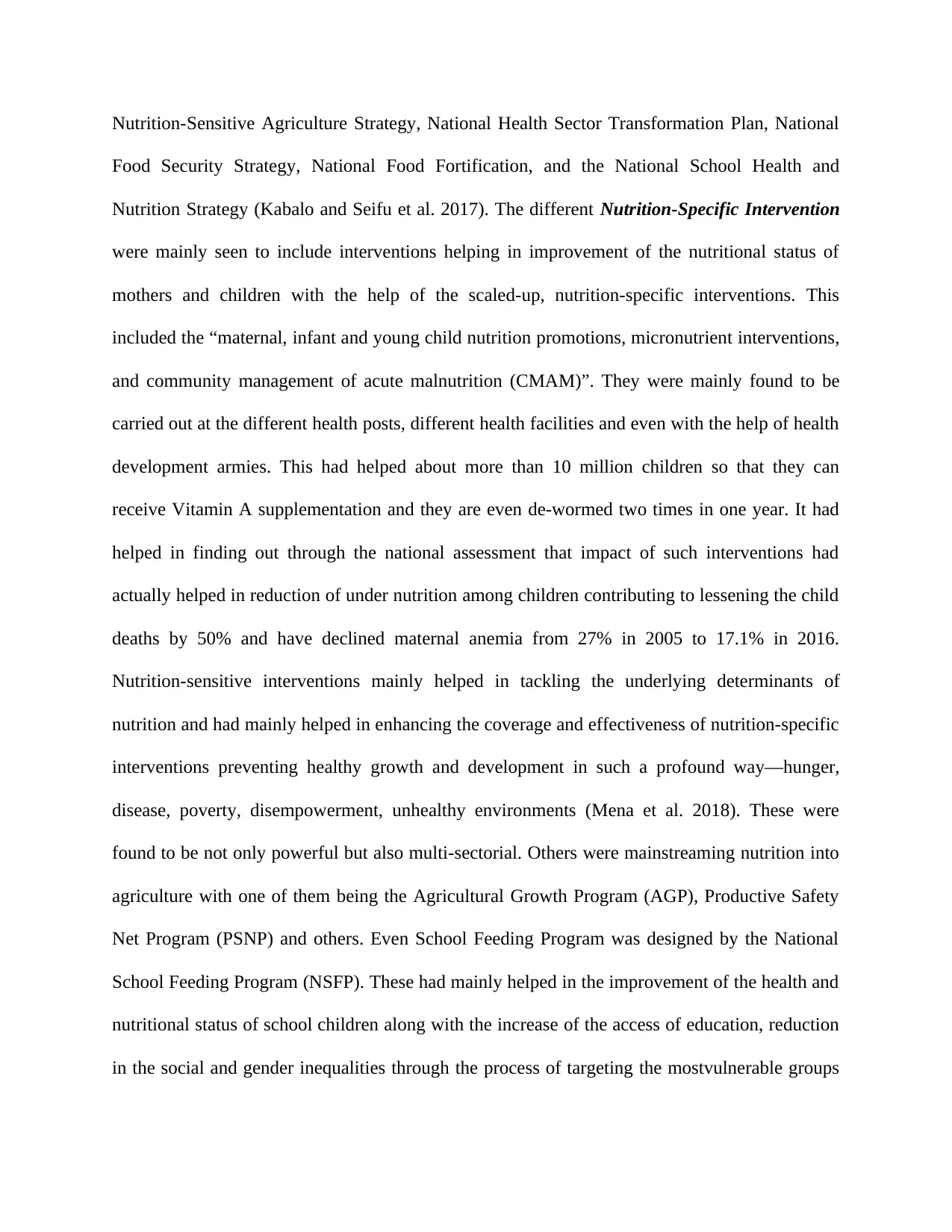
Nutrition-Sensitive Agriculture Strategy, National Health Sector Transformation Plan, National
Food Security Strategy, National Food Fortification, and the National School Health and
Nutrition Strategy (Kabalo and Seifu et al. 2017). The different Nutrition-Specific Intervention
were mainly seen to include interventions helping in improvement of the nutritional status of
mothers and children with the help of the scaled-up, nutrition-specific interventions. This
included the “maternal, infant and young child nutrition promotions, micronutrient interventions,
and community management of acute malnutrition (CMAM)”. They were mainly found to be
carried out at the different health posts, different health facilities and even with the help of health
development armies. This had helped about more than 10 million children so that they can
receive Vitamin A supplementation and they are even de-wormed two times in one year. It had
helped in finding out through the national assessment that impact of such interventions had
actually helped in reduction of under nutrition among children contributing to lessening the child
deaths by 50% and have declined maternal anemia from 27% in 2005 to 17.1% in 2016.
Nutrition-sensitive interventions mainly helped in tackling the underlying determinants of
nutrition and had mainly helped in enhancing the coverage and effectiveness of nutrition-specific
interventions preventing healthy growth and development in such a profound way—hunger,
disease, poverty, disempowerment, unhealthy environments (Mena et al. 2018). These were
found to be not only powerful but also multi-sectorial. Others were mainstreaming nutrition into
agriculture with one of them being the Agricultural Growth Program (AGP), Productive Safety
Net Program (PSNP) and others. Even School Feeding Program was designed by the National
School Feeding Program (NSFP). These had mainly helped in the improvement of the health and
nutritional status of school children along with the increase of the access of education, reduction
in the social and gender inequalities through the process of targeting the mostvulnerable groups
Food Security Strategy, National Food Fortification, and the National School Health and
Nutrition Strategy (Kabalo and Seifu et al. 2017). The different Nutrition-Specific Intervention
were mainly seen to include interventions helping in improvement of the nutritional status of
mothers and children with the help of the scaled-up, nutrition-specific interventions. This
included the “maternal, infant and young child nutrition promotions, micronutrient interventions,
and community management of acute malnutrition (CMAM)”. They were mainly found to be
carried out at the different health posts, different health facilities and even with the help of health
development armies. This had helped about more than 10 million children so that they can
receive Vitamin A supplementation and they are even de-wormed two times in one year. It had
helped in finding out through the national assessment that impact of such interventions had
actually helped in reduction of under nutrition among children contributing to lessening the child
deaths by 50% and have declined maternal anemia from 27% in 2005 to 17.1% in 2016.
Nutrition-sensitive interventions mainly helped in tackling the underlying determinants of
nutrition and had mainly helped in enhancing the coverage and effectiveness of nutrition-specific
interventions preventing healthy growth and development in such a profound way—hunger,
disease, poverty, disempowerment, unhealthy environments (Mena et al. 2018). These were
found to be not only powerful but also multi-sectorial. Others were mainstreaming nutrition into
agriculture with one of them being the Agricultural Growth Program (AGP), Productive Safety
Net Program (PSNP) and others. Even School Feeding Program was designed by the National
School Feeding Program (NSFP). These had mainly helped in the improvement of the health and
nutritional status of school children along with the increase of the access of education, reduction
in the social and gender inequalities through the process of targeting the mostvulnerable groups
Paraphrase This Document
Need a fresh take? Get an instant paraphrase of this document with our AI Paraphraser
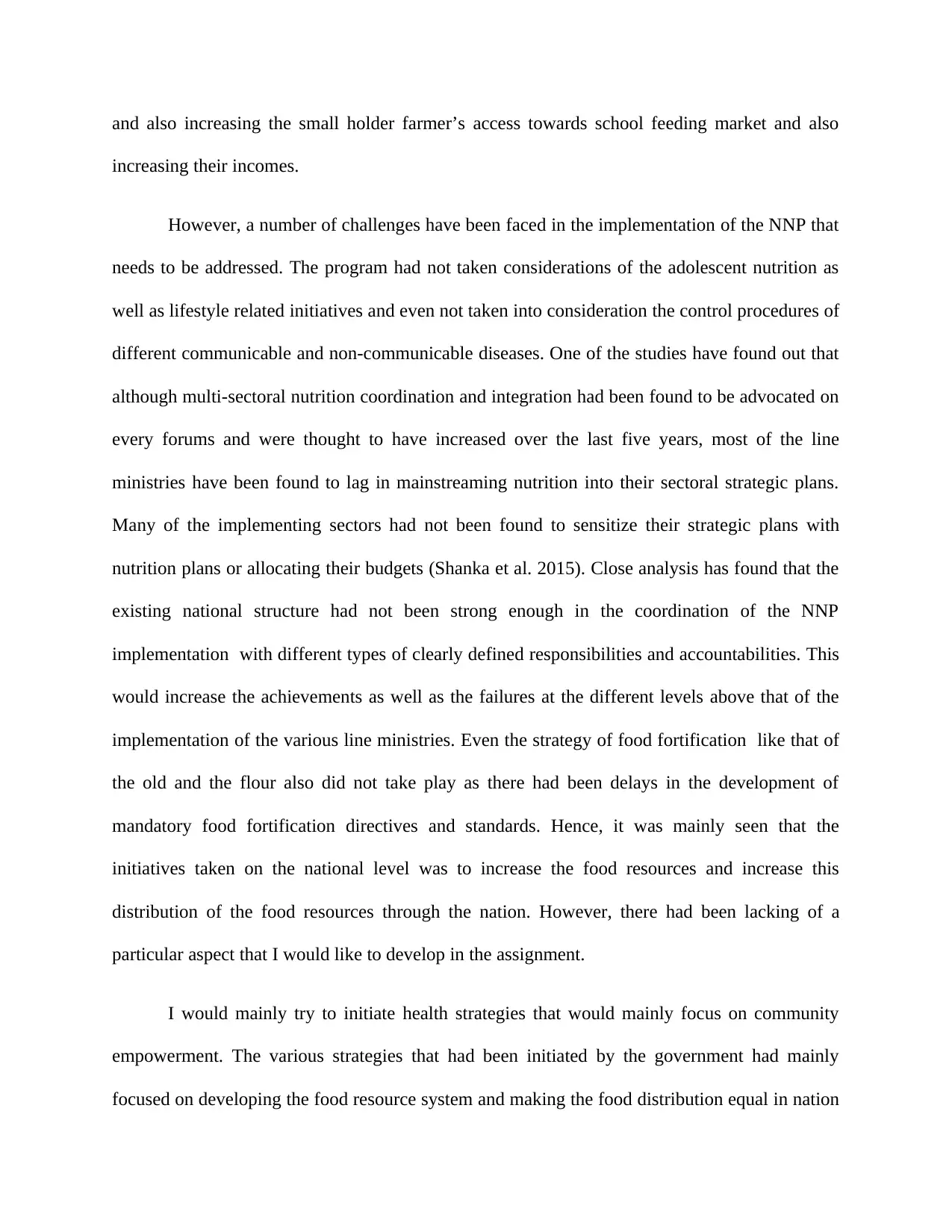
and also increasing the small holder farmer’s access towards school feeding market and also
increasing their incomes.
However, a number of challenges have been faced in the implementation of the NNP that
needs to be addressed. The program had not taken considerations of the adolescent nutrition as
well as lifestyle related initiatives and even not taken into consideration the control procedures of
different communicable and non-communicable diseases. One of the studies have found out that
although multi-sectoral nutrition coordination and integration had been found to be advocated on
every forums and were thought to have increased over the last five years, most of the line
ministries have been found to lag in mainstreaming nutrition into their sectoral strategic plans.
Many of the implementing sectors had not been found to sensitize their strategic plans with
nutrition plans or allocating their budgets (Shanka et al. 2015). Close analysis has found that the
existing national structure had not been strong enough in the coordination of the NNP
implementation with different types of clearly defined responsibilities and accountabilities. This
would increase the achievements as well as the failures at the different levels above that of the
implementation of the various line ministries. Even the strategy of food fortification like that of
the old and the flour also did not take play as there had been delays in the development of
mandatory food fortification directives and standards. Hence, it was mainly seen that the
initiatives taken on the national level was to increase the food resources and increase this
distribution of the food resources through the nation. However, there had been lacking of a
particular aspect that I would like to develop in the assignment.
I would mainly try to initiate health strategies that would mainly focus on community
empowerment. The various strategies that had been initiated by the government had mainly
focused on developing the food resource system and making the food distribution equal in nation
increasing their incomes.
However, a number of challenges have been faced in the implementation of the NNP that
needs to be addressed. The program had not taken considerations of the adolescent nutrition as
well as lifestyle related initiatives and even not taken into consideration the control procedures of
different communicable and non-communicable diseases. One of the studies have found out that
although multi-sectoral nutrition coordination and integration had been found to be advocated on
every forums and were thought to have increased over the last five years, most of the line
ministries have been found to lag in mainstreaming nutrition into their sectoral strategic plans.
Many of the implementing sectors had not been found to sensitize their strategic plans with
nutrition plans or allocating their budgets (Shanka et al. 2015). Close analysis has found that the
existing national structure had not been strong enough in the coordination of the NNP
implementation with different types of clearly defined responsibilities and accountabilities. This
would increase the achievements as well as the failures at the different levels above that of the
implementation of the various line ministries. Even the strategy of food fortification like that of
the old and the flour also did not take play as there had been delays in the development of
mandatory food fortification directives and standards. Hence, it was mainly seen that the
initiatives taken on the national level was to increase the food resources and increase this
distribution of the food resources through the nation. However, there had been lacking of a
particular aspect that I would like to develop in the assignment.
I would mainly try to initiate health strategies that would mainly focus on community
empowerment. The various strategies that had been initiated by the government had mainly
focused on developing the food resource system and making the food distribution equal in nation
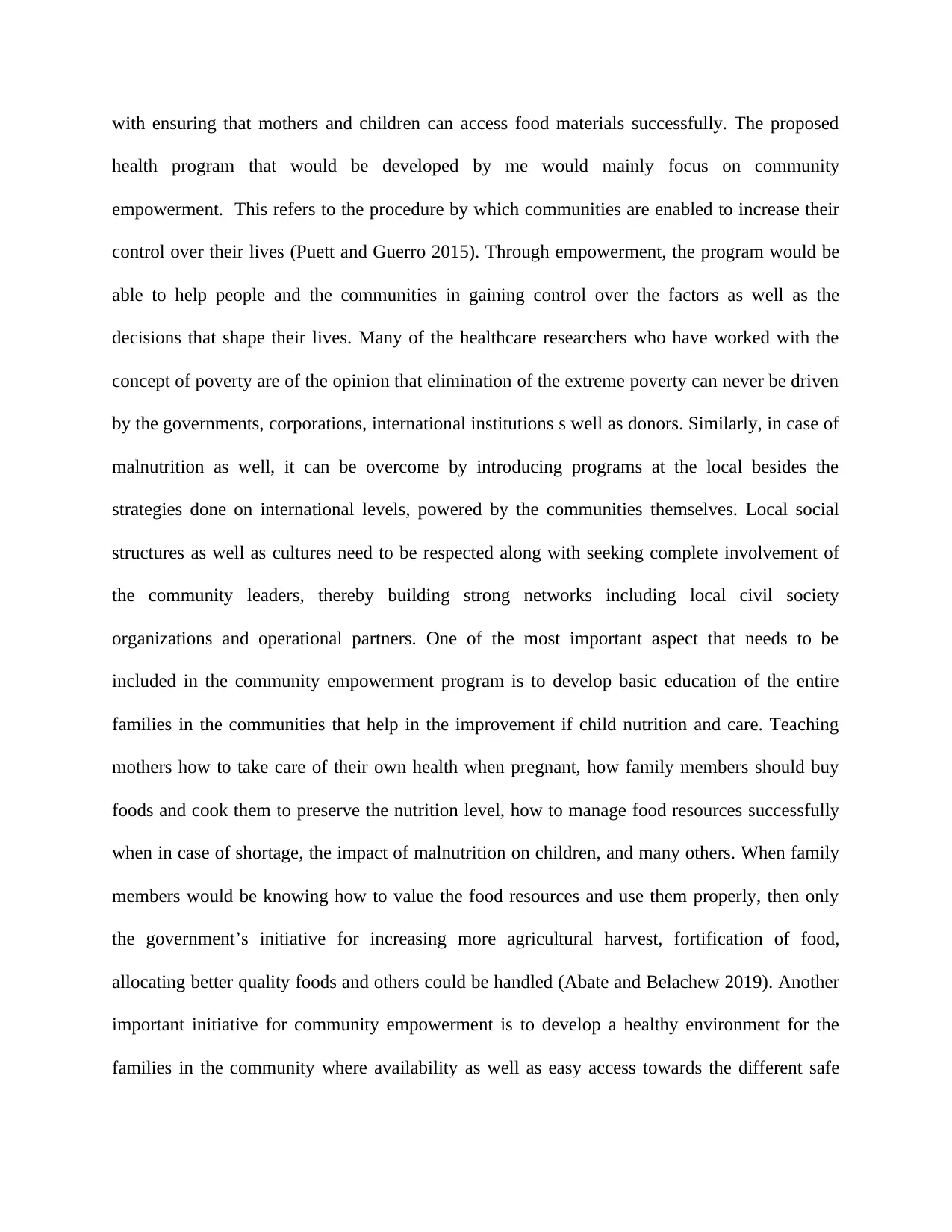
with ensuring that mothers and children can access food materials successfully. The proposed
health program that would be developed by me would mainly focus on community
empowerment. This refers to the procedure by which communities are enabled to increase their
control over their lives (Puett and Guerro 2015). Through empowerment, the program would be
able to help people and the communities in gaining control over the factors as well as the
decisions that shape their lives. Many of the healthcare researchers who have worked with the
concept of poverty are of the opinion that elimination of the extreme poverty can never be driven
by the governments, corporations, international institutions s well as donors. Similarly, in case of
malnutrition as well, it can be overcome by introducing programs at the local besides the
strategies done on international levels, powered by the communities themselves. Local social
structures as well as cultures need to be respected along with seeking complete involvement of
the community leaders, thereby building strong networks including local civil society
organizations and operational partners. One of the most important aspect that needs to be
included in the community empowerment program is to develop basic education of the entire
families in the communities that help in the improvement if child nutrition and care. Teaching
mothers how to take care of their own health when pregnant, how family members should buy
foods and cook them to preserve the nutrition level, how to manage food resources successfully
when in case of shortage, the impact of malnutrition on children, and many others. When family
members would be knowing how to value the food resources and use them properly, then only
the government’s initiative for increasing more agricultural harvest, fortification of food,
allocating better quality foods and others could be handled (Abate and Belachew 2019). Another
important initiative for community empowerment is to develop a healthy environment for the
families in the community where availability as well as easy access towards the different safe
health program that would be developed by me would mainly focus on community
empowerment. This refers to the procedure by which communities are enabled to increase their
control over their lives (Puett and Guerro 2015). Through empowerment, the program would be
able to help people and the communities in gaining control over the factors as well as the
decisions that shape their lives. Many of the healthcare researchers who have worked with the
concept of poverty are of the opinion that elimination of the extreme poverty can never be driven
by the governments, corporations, international institutions s well as donors. Similarly, in case of
malnutrition as well, it can be overcome by introducing programs at the local besides the
strategies done on international levels, powered by the communities themselves. Local social
structures as well as cultures need to be respected along with seeking complete involvement of
the community leaders, thereby building strong networks including local civil society
organizations and operational partners. One of the most important aspect that needs to be
included in the community empowerment program is to develop basic education of the entire
families in the communities that help in the improvement if child nutrition and care. Teaching
mothers how to take care of their own health when pregnant, how family members should buy
foods and cook them to preserve the nutrition level, how to manage food resources successfully
when in case of shortage, the impact of malnutrition on children, and many others. When family
members would be knowing how to value the food resources and use them properly, then only
the government’s initiative for increasing more agricultural harvest, fortification of food,
allocating better quality foods and others could be handled (Abate and Belachew 2019). Another
important initiative for community empowerment is to develop a healthy environment for the
families in the community where availability as well as easy access towards the different safe
⊘ This is a preview!⊘
Do you want full access?
Subscribe today to unlock all pages.

Trusted by 1+ million students worldwide
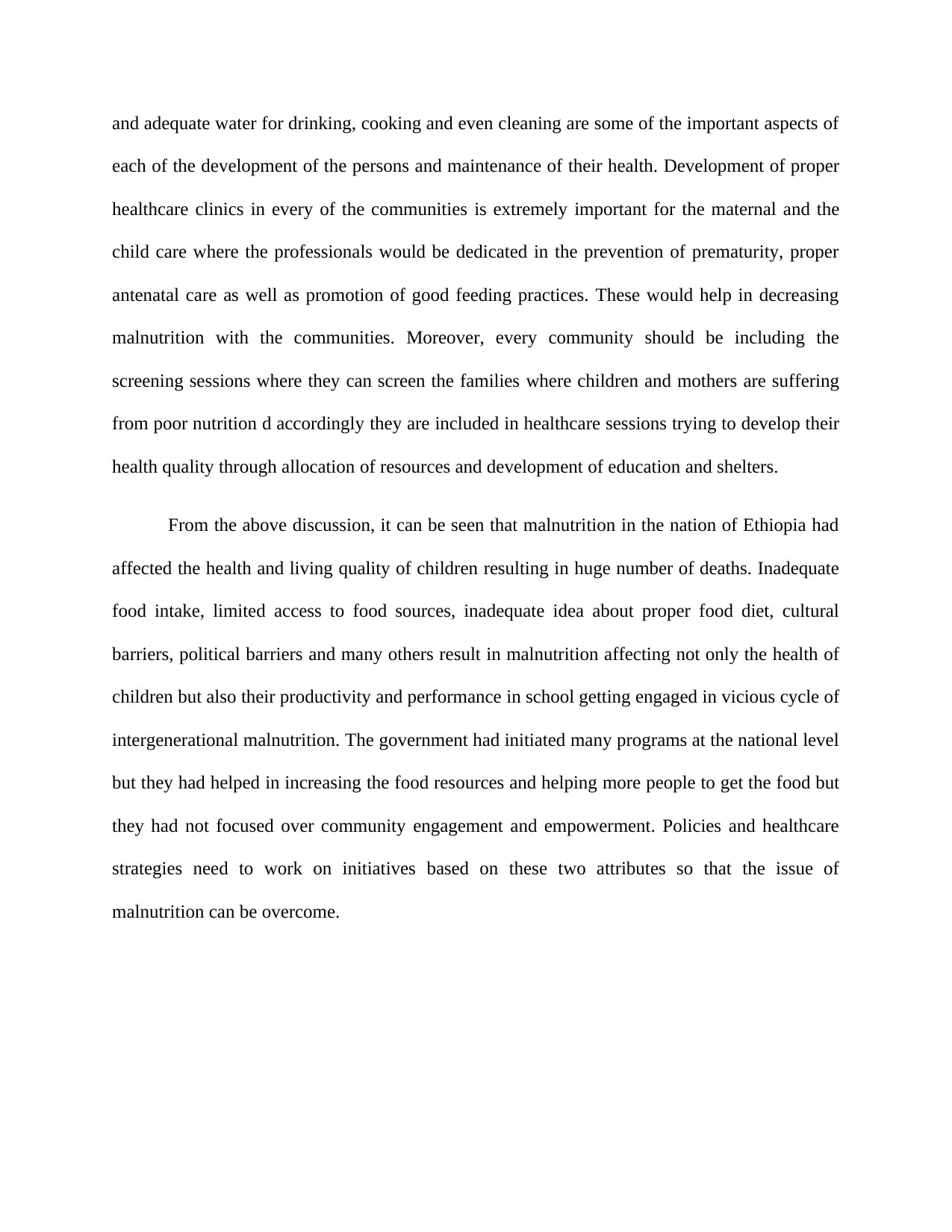
and adequate water for drinking, cooking and even cleaning are some of the important aspects of
each of the development of the persons and maintenance of their health. Development of proper
healthcare clinics in every of the communities is extremely important for the maternal and the
child care where the professionals would be dedicated in the prevention of prematurity, proper
antenatal care as well as promotion of good feeding practices. These would help in decreasing
malnutrition with the communities. Moreover, every community should be including the
screening sessions where they can screen the families where children and mothers are suffering
from poor nutrition d accordingly they are included in healthcare sessions trying to develop their
health quality through allocation of resources and development of education and shelters.
From the above discussion, it can be seen that malnutrition in the nation of Ethiopia had
affected the health and living quality of children resulting in huge number of deaths. Inadequate
food intake, limited access to food sources, inadequate idea about proper food diet, cultural
barriers, political barriers and many others result in malnutrition affecting not only the health of
children but also their productivity and performance in school getting engaged in vicious cycle of
intergenerational malnutrition. The government had initiated many programs at the national level
but they had helped in increasing the food resources and helping more people to get the food but
they had not focused over community engagement and empowerment. Policies and healthcare
strategies need to work on initiatives based on these two attributes so that the issue of
malnutrition can be overcome.
each of the development of the persons and maintenance of their health. Development of proper
healthcare clinics in every of the communities is extremely important for the maternal and the
child care where the professionals would be dedicated in the prevention of prematurity, proper
antenatal care as well as promotion of good feeding practices. These would help in decreasing
malnutrition with the communities. Moreover, every community should be including the
screening sessions where they can screen the families where children and mothers are suffering
from poor nutrition d accordingly they are included in healthcare sessions trying to develop their
health quality through allocation of resources and development of education and shelters.
From the above discussion, it can be seen that malnutrition in the nation of Ethiopia had
affected the health and living quality of children resulting in huge number of deaths. Inadequate
food intake, limited access to food sources, inadequate idea about proper food diet, cultural
barriers, political barriers and many others result in malnutrition affecting not only the health of
children but also their productivity and performance in school getting engaged in vicious cycle of
intergenerational malnutrition. The government had initiated many programs at the national level
but they had helped in increasing the food resources and helping more people to get the food but
they had not focused over community engagement and empowerment. Policies and healthcare
strategies need to work on initiatives based on these two attributes so that the issue of
malnutrition can be overcome.
Paraphrase This Document
Need a fresh take? Get an instant paraphrase of this document with our AI Paraphraser
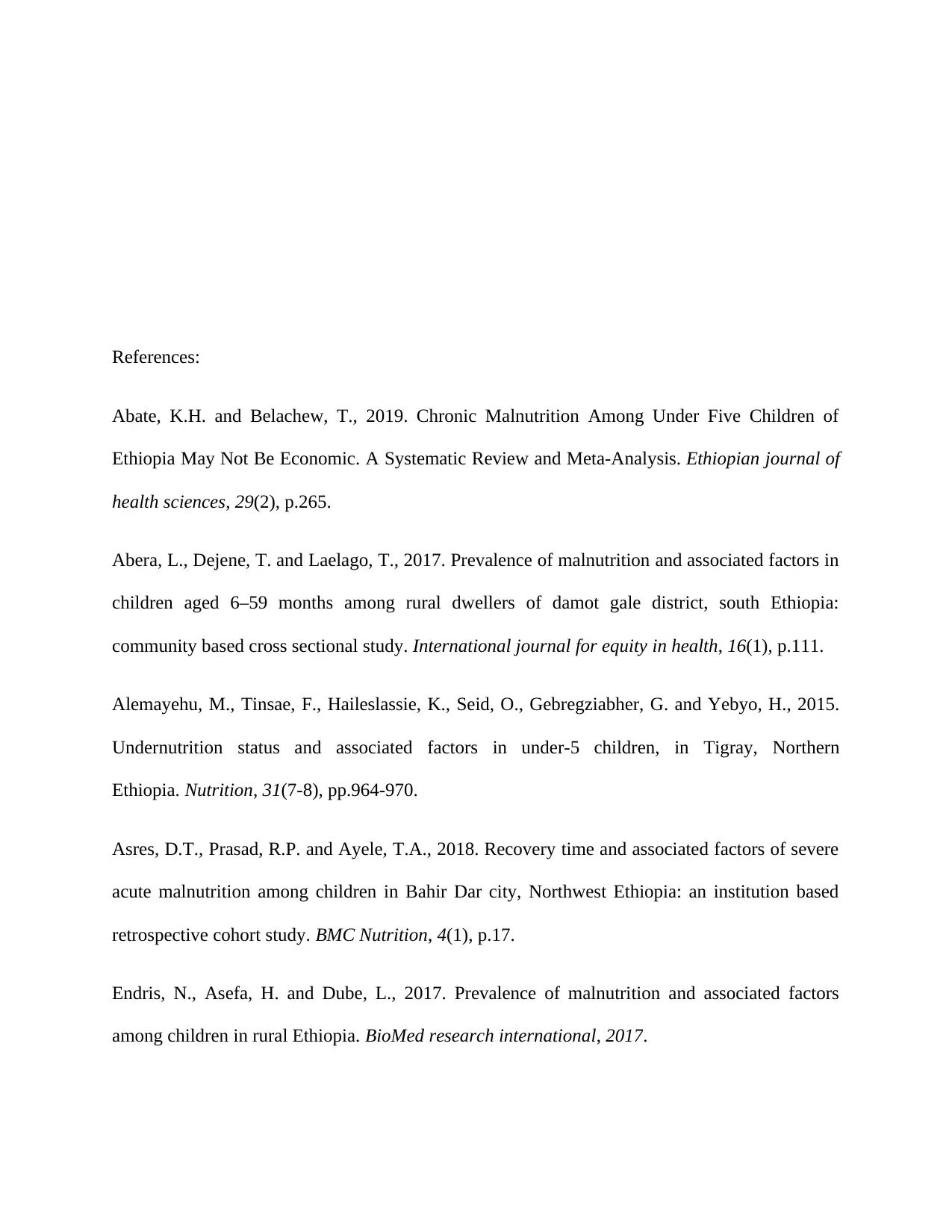
References:
Abate, K.H. and Belachew, T., 2019. Chronic Malnutrition Among Under Five Children of
Ethiopia May Not Be Economic. A Systematic Review and Meta-Analysis. Ethiopian journal of
health sciences, 29(2), p.265.
Abera, L., Dejene, T. and Laelago, T., 2017. Prevalence of malnutrition and associated factors in
children aged 6–59 months among rural dwellers of damot gale district, south Ethiopia:
community based cross sectional study. International journal for equity in health, 16(1), p.111.
Alemayehu, M., Tinsae, F., Haileslassie, K., Seid, O., Gebregziabher, G. and Yebyo, H., 2015.
Undernutrition status and associated factors in under-5 children, in Tigray, Northern
Ethiopia. Nutrition, 31(7-8), pp.964-970.
Asres, D.T., Prasad, R.P. and Ayele, T.A., 2018. Recovery time and associated factors of severe
acute malnutrition among children in Bahir Dar city, Northwest Ethiopia: an institution based
retrospective cohort study. BMC Nutrition, 4(1), p.17.
Endris, N., Asefa, H. and Dube, L., 2017. Prevalence of malnutrition and associated factors
among children in rural Ethiopia. BioMed research international, 2017.
Abate, K.H. and Belachew, T., 2019. Chronic Malnutrition Among Under Five Children of
Ethiopia May Not Be Economic. A Systematic Review and Meta-Analysis. Ethiopian journal of
health sciences, 29(2), p.265.
Abera, L., Dejene, T. and Laelago, T., 2017. Prevalence of malnutrition and associated factors in
children aged 6–59 months among rural dwellers of damot gale district, south Ethiopia:
community based cross sectional study. International journal for equity in health, 16(1), p.111.
Alemayehu, M., Tinsae, F., Haileslassie, K., Seid, O., Gebregziabher, G. and Yebyo, H., 2015.
Undernutrition status and associated factors in under-5 children, in Tigray, Northern
Ethiopia. Nutrition, 31(7-8), pp.964-970.
Asres, D.T., Prasad, R.P. and Ayele, T.A., 2018. Recovery time and associated factors of severe
acute malnutrition among children in Bahir Dar city, Northwest Ethiopia: an institution based
retrospective cohort study. BMC Nutrition, 4(1), p.17.
Endris, N., Asefa, H. and Dube, L., 2017. Prevalence of malnutrition and associated factors
among children in rural Ethiopia. BioMed research international, 2017.
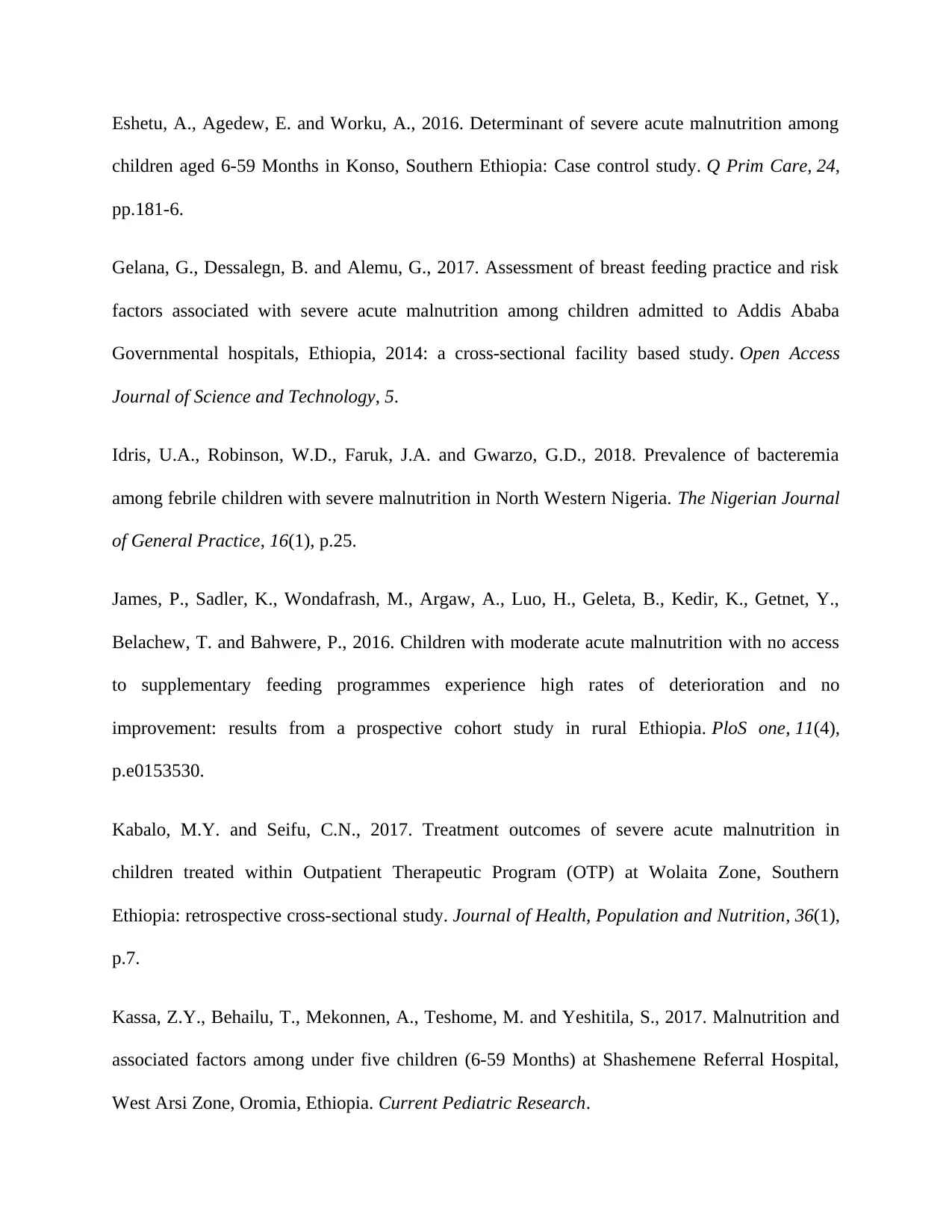
Eshetu, A., Agedew, E. and Worku, A., 2016. Determinant of severe acute malnutrition among
children aged 6-59 Months in Konso, Southern Ethiopia: Case control study. Q Prim Care, 24,
pp.181-6.
Gelana, G., Dessalegn, B. and Alemu, G., 2017. Assessment of breast feeding practice and risk
factors associated with severe acute malnutrition among children admitted to Addis Ababa
Governmental hospitals, Ethiopia, 2014: a cross-sectional facility based study. Open Access
Journal of Science and Technology, 5.
Idris, U.A., Robinson, W.D., Faruk, J.A. and Gwarzo, G.D., 2018. Prevalence of bacteremia
among febrile children with severe malnutrition in North Western Nigeria. The Nigerian Journal
of General Practice, 16(1), p.25.
James, P., Sadler, K., Wondafrash, M., Argaw, A., Luo, H., Geleta, B., Kedir, K., Getnet, Y.,
Belachew, T. and Bahwere, P., 2016. Children with moderate acute malnutrition with no access
to supplementary feeding programmes experience high rates of deterioration and no
improvement: results from a prospective cohort study in rural Ethiopia. PloS one, 11(4),
p.e0153530.
Kabalo, M.Y. and Seifu, C.N., 2017. Treatment outcomes of severe acute malnutrition in
children treated within Outpatient Therapeutic Program (OTP) at Wolaita Zone, Southern
Ethiopia: retrospective cross-sectional study. Journal of Health, Population and Nutrition, 36(1),
p.7.
Kassa, Z.Y., Behailu, T., Mekonnen, A., Teshome, M. and Yeshitila, S., 2017. Malnutrition and
associated factors among under five children (6-59 Months) at Shashemene Referral Hospital,
West Arsi Zone, Oromia, Ethiopia. Current Pediatric Research.
children aged 6-59 Months in Konso, Southern Ethiopia: Case control study. Q Prim Care, 24,
pp.181-6.
Gelana, G., Dessalegn, B. and Alemu, G., 2017. Assessment of breast feeding practice and risk
factors associated with severe acute malnutrition among children admitted to Addis Ababa
Governmental hospitals, Ethiopia, 2014: a cross-sectional facility based study. Open Access
Journal of Science and Technology, 5.
Idris, U.A., Robinson, W.D., Faruk, J.A. and Gwarzo, G.D., 2018. Prevalence of bacteremia
among febrile children with severe malnutrition in North Western Nigeria. The Nigerian Journal
of General Practice, 16(1), p.25.
James, P., Sadler, K., Wondafrash, M., Argaw, A., Luo, H., Geleta, B., Kedir, K., Getnet, Y.,
Belachew, T. and Bahwere, P., 2016. Children with moderate acute malnutrition with no access
to supplementary feeding programmes experience high rates of deterioration and no
improvement: results from a prospective cohort study in rural Ethiopia. PloS one, 11(4),
p.e0153530.
Kabalo, M.Y. and Seifu, C.N., 2017. Treatment outcomes of severe acute malnutrition in
children treated within Outpatient Therapeutic Program (OTP) at Wolaita Zone, Southern
Ethiopia: retrospective cross-sectional study. Journal of Health, Population and Nutrition, 36(1),
p.7.
Kassa, Z.Y., Behailu, T., Mekonnen, A., Teshome, M. and Yeshitila, S., 2017. Malnutrition and
associated factors among under five children (6-59 Months) at Shashemene Referral Hospital,
West Arsi Zone, Oromia, Ethiopia. Current Pediatric Research.
⊘ This is a preview!⊘
Do you want full access?
Subscribe today to unlock all pages.

Trusted by 1+ million students worldwide
1 out of 14
Related Documents
Your All-in-One AI-Powered Toolkit for Academic Success.
+13062052269
info@desklib.com
Available 24*7 on WhatsApp / Email
![[object Object]](/_next/static/media/star-bottom.7253800d.svg)
Unlock your academic potential
Copyright © 2020–2025 A2Z Services. All Rights Reserved. Developed and managed by ZUCOL.




